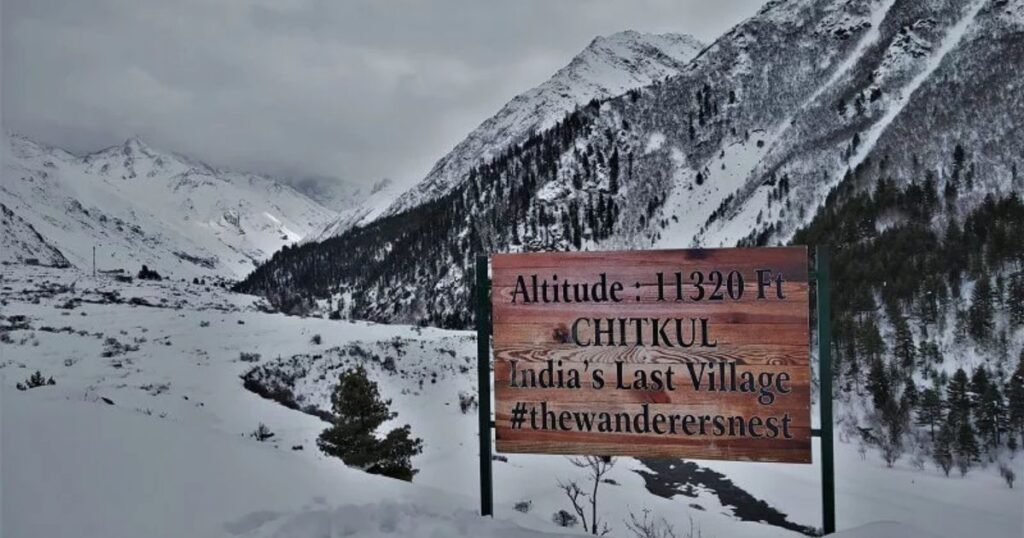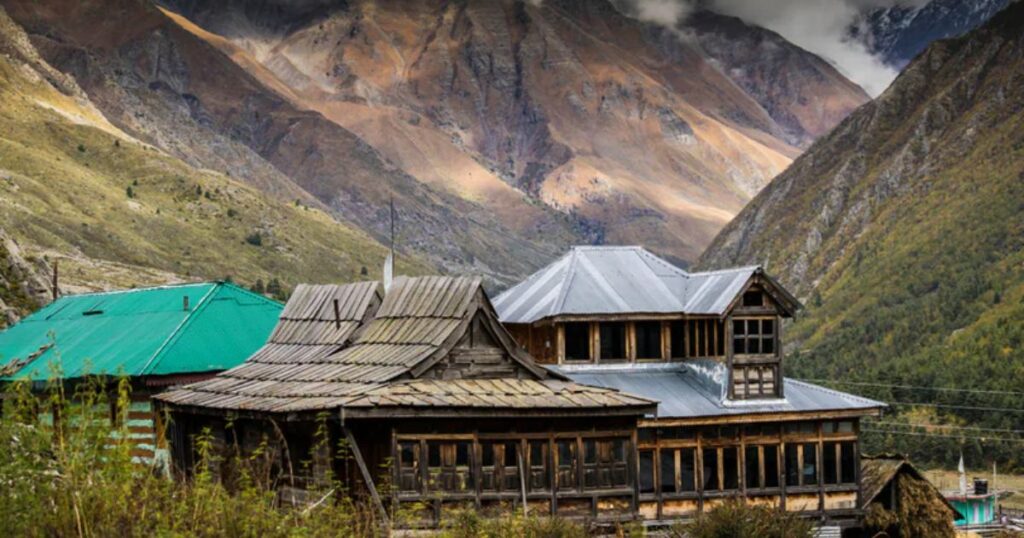Perched at an elevation of 3,450 meters in Himachal Pradesh's Kinnaur district, Chitkul stands as India's last inhabited village before the Indo-Tibet border. This picturesque hamlet, surrounded by majestic snow-capped peaks, apple orchards, and the crystal-clear Baspa River, captivates travelers with its untouched beauty and traditional Kinnauri culture. For those planning a journey to this remote Himalayan paradise, timing your visit can significantly enhance your experience. The best time to visit Chitkul is during the summer months from May to October when the roads are accessible, skies are clear, and the weather is pleasantly cool for exploring its stunning landscapes.
This remote village, often called the "last place on earth," offers a tranquil retreat from bustling tourist destinations, with its wooden houses, ancient temples, and panoramic mountain vistas. While Chitkul can theoretically be visited for a brief period during winter, the region experiences heavy snowfall that often blocks access routes and limits activities. Understanding seasonal variations is crucial for planning a fulfilling journey to this high-altitude destination on the old Hindustan-Tibet trade route.
Table of Contents
Seasonal Comparison Table for Visiting Chitkul
To help you determine the best time to visit Chitkul based on your travel preferences, here's a comparative overview of all seasons:
| Season | Months | Temperature (°C) | Weather | Accessibility | Recommendation |
|---|---|---|---|---|---|
| Summer | May-Jun | 15-25 | Pleasant, occasional rain | Good | Highly Recommended |
| Monsoon | Jul-Aug | 12-22 | Intermittent rainfall | Moderate with occasional disruptions | Moderate |
| Autumn | Sep-Oct | 10-20 | Clear, crisp, minimal rain | Excellent | Highly Recommended |
| Winter | Nov-Apr | -15 to 5 | Heavy snowfall, freezing | Poor to Inaccessible | Not Recommended |
Best Time to Visit Chitkul by Season

Before finalizing your travel plans, it's important to understand how different seasons affect the Chitkul experience. Each period offers distinct advantages and limitations that can significantly impact your journey to this remote Himalayan village.
Most travelers combine their Chitkul trip with a broader Himachal Pradesh itinerary, with many starting from Shimla or including Chitkul as part of Himachal Pradesh tour packages from Mumbai that cover multiple destinations in the region.
1. Summer Season (May to June)
Early summer provides the first window of reliable access to Chitkul after the winter closure, offering comfortable temperatures and blooming landscapes.
Temperature Range: 15-25°C (59-77°F)
Weather Conditions: Pleasant days with cool evenings, occasional light rainfall
Accessibility: Roads typically open by mid-May, depending on snow clearance
Natural Attractions: Wildflowers in bloom, green meadows, clear mountain views
Crowd Levels: Moderate, building throughout June
2. Monsoon Season (July to August)
The monsoon brings both challenges and unique beauty to Chitkul, with lush landscapes contrasted against occasional road disruptions.
Temperature Range: 12-22°C (54-72°F)
Weather Conditions: Intermittent rainfall, potential landslides in the region
Accessibility: Roads remain open but occasional blockages due to landslides
Natural Attractions: Lush green landscapes, flowing streams, misty mountain views
Crowd Levels: Lower than summer, primarily adventurous travelers
3. Autumn Season (September to October)
Autumn represents the golden period for visiting Chitkul, combining excellent weather, spectacular colors, and cultural festivities.
Temperature Range: 10-20°C (50-68°F)
Weather Conditions: Clear skies, minimal rainfall, crisp mountain air
Accessibility: Excellent road conditions with rare disruptions
Natural Attractions: Golden hues of changing foliage, apple harvest, crystal-clear views
Crowd Levels: Moderate, with a peak during October holiday weeks
4. Winter Season (November to April)
Winter transforms Chitkul into a snow-covered wonderland but severely restricts access and accommodations.
Temperature Range: -15 to 5°C (5-41°F)
Weather Conditions: Heavy snowfall, freezing temperatures, limited daylight
Accessibility: Roads typically closed from December to April
Natural Attractions: Snow-covered landscapes, pristine winter scenery
Crowd Levels: Very low, almost deserted by mid-December
Typical Monthly Weather Patterns
Monthly weather variations in Chitkul follow a predictable pattern, though specific conditions can vary year to year:
- January-February: Extreme cold with temperatures often below -10°C, heavy snow accumulation, roads closed
- March-April: Gradually warming but still cold (0-10°C), snow melting begins, roads typically remain closed
- May: Spring emergence with temperatures reaching 15-20°C, road access usually restored by mid-month
- June: Pleasant summer conditions (15-25°C), clear skies with occasional afternoon showers
- July-August: Monsoon influence with moderate rainfall, temperatures between 12-22°C
- September: Post-monsoon clarity with comfortable temperatures (10-20°C), excellent visibility
- October: Autumn colors with cooling temperatures (5-15°C), crisp mountain air
- November: Winter onset with temperatures dropping to 0-10°C, potential early snowfall
- December: Full winter conditions with sub-zero temperatures, heavy snowfall, village largely evacuated
How to Reach Chitkul
Reaching this remote Himalayan village requires planning and potentially multiple transportation modes. The journey itself offers spectacular views through Kinnaur Valley, especially when traveling during the best time to visit Chitkul.
Flights to Chitkul: Nearest Airports
While there are no direct flights to Chitkul as the village has no airport, several airports serve as access points to begin your journey:
- Shimla Airport (Jubbarhatti):
- Distance from Chitkul: 250 km
- Travel Time: 9-10 hours by road
- Connectivity: Limited flights from Delhi operated by Alliance Air
- Road Journey: Shimla → Narkanda → Rampur → Karcham → Sangla → Chitkul
- Bhuntar Airport (Kullu):
- Distance from Chitkul: 280 km
- Travel Time: 10-12 hours by road
- Connectivity: Flights from Delhi on specific days
- Road Journey: Kullu → Mandi → Shimla → Karcham → Sangla → Chitkul
- Chandigarh Airport:
- Distance from Chitkul: 380 km
- Travel Time: 12-14 hours by road
- Connectivity: Good domestic connections from major Indian cities
- Road Journey: Chandigarh → Shimla → Narkanda → Karcham → Sangla → Chitkul
Most travelers combine their Chitkul trip with a broader Himachal Pradesh itinerary, with many starting from Shimla or including Chitkul as part of Himachal Pradesh tour packages from Mumbai that cover multiple destinations in the region.
Transportation Options to Chitkul
- Private Taxi:
- Most convenient option
- Cost: ₹4,000-5,000 from Shimla to Chitkul
- Benefits: Flexibility for photo stops, comfort
- Shared Taxi/Jeep:
- Available from Reckong Peo and Sangla
- Cost: ₹200-300 per person from Sangla
- Timing: Limited departures, typically morning only
- HRTC Bus Service:
- Limited service during summer and autumn only
- Direct bus from Shimla to Chitkul (seasonal)
- More frequent connections to Sangla with onward shared taxis
- Cost: ₹500-600 from Shimla to Chitkul
- Note: Service dependent on road conditions and season
Most travelers combine their Chitkul trip with a broader Himachal Pradesh itinerary, with many starting from Shimla or including Chitkul as part of Himachal Pradesh tour packages from Mumbai that cover multiple destinations in the region.
Kalpa to Chitkul Journey
Route Details:
- Distance: Approximately 60 km
- Travel Time: 4-5 hours by road
- Route: Kalpa → Powari → Rekong Peo → Karcham → Sangla → Rakcham → Chitkul
- Road Type: Winding mountain roads, some sections along cliff edges
Recommended Itinerary:
- Morning departure from Kalpa after sunrise views of Kinner Kailash
- Brief stop at Rekong Peo (district headquarters)
- Photo stop at Karcham Dam and confluence point
- Lunch break in Sangla
- Evening arrival in Chitkul
This journey offers diverse landscapes as you travel from the terraced fields of Kalpa through the administrative center of Rekong Peo, then follow the Baspa River into its increasingly remote valley that terminates at Chitkul.
Things to Do in Chitkul

Despite its small size and remote location, Chitkul offers numerous activities that connect visitors with its natural beauty and cultural heritage. The available activities vary by season, with the best time to visit Chitkul offering the most diverse options.
1. Explore Chitkul Village
Walking through the ancient village provides insight into traditional Kinnauri architecture and lifestyle:
- Visit the 500-year-old Mathi Temple with unique wooden architecture
- Observe traditional slate-roofed houses with intricate woodwork
- Interact with locals to learn about their seasonal migration patterns
- Photograph the village against its stunning mountain backdrop
- Visit the small local market for handcrafted Kinnauri items
2. Hiking and Nature Walks
The surrounding mountains offer numerous trails for various experience levels:
- Baspa River Trail:
- Difficulty: Easy
- Duration: 1-2 hours
- Highlights: River views, wildflowers, bird watching
- Indo-Tibet Border Hike:
- Difficulty: Moderate
- Duration: 4-5 hours round trip
- Highlights: Views of border markers, higher elevation landscapes
- Note: Permits may be required; check current regulations
- Nagasti Meadows:
- Difficulty: Moderate
- Duration: 3-4 hours round trip
- Highlights: Alpine meadows, grazing grounds, panoramic views
3. Cultural Experiences
Engaging with local culture provides deeper insights into this unique region:
- Attend local festivals if your visit coincides (primarily summer months)
- Sample traditional Kinnauri cuisine in local homes
- Observe traditional weaving of Kinnauri shawls
- Learn about the unique dialect and customs of the region
Most travelers combine their Chitkul trip with a broader Himachal Pradesh itinerary, with many starting from Shimla or including Chitkul as part of Himachal Pradesh tour packages from Mumbai that cover multiple destinations in the region.
Chitkul Tourist Places: Beyond the Village
While Chitkul itself is the primary attraction, several nearby points of interest enhance the experience of visiting this remote region.
1. Rakcham Village
Located 9 km before Chitkul, this picturesque village offers:
- Less crowded environment than Chitkul
- Beautiful apple orchards and potato fields
- Authentic homestay experiences
- Starting point for several hiking trails
- Ancient wooden bridge across the Baspa River
2. Baspa River Viewpoints
Several designated spots along the road to Chitkul offer spectacular views:
- Karcham confluence where Baspa meets Satluj
- Several pull-off points between Sangla and Chitkul
- Evening light creating golden reflections on the water
3. Last Dhaba of India
This famous eatery at the edge of Chitkul has become an attraction itself:
- Simple but delicious mountain fare
- Spectacular location with panoramic views
- Photo opportunity with their iconic signboard
- Limited operating season (May-October only)
4. Sangla Valley Attractions
Just 28 km from Chitkul, Sangla offers additional experiences:
- Kamru Fort: Ancient tower structure with significant religious importance
- Bering Nag Temple: Traditional wood-carved temple with local festivals
- Sangla Meadows: Beautiful flat valley floor with camping options
- Local markets with Kinnauri handicrafts and agricultural products
5. Batseri Village
Located between Sangla and Chitkul:
- Traditional architecture preserved better than in more touristic areas
- Ancient temple and cultural heritage
- Famous wooden bridge featured in many Bollywood films
- Apple and apricot orchards with potential for fruit picking (season dependent)
also you can check our latest blog adventure travel in India to know more about the places that are full of adventure and fun.
Conclusion:
The best time to visit Chitkul ultimately depends on your specific interests and priorities. For most travelers, the autumn months of September and October offer the ideal combination of clear weather, comfortable temperatures, spectacular colors, and good road conditions. The summer period from May to June provides another excellent window with blooming wildflowers and pleasant temperatures, though with slightly higher chances of precipitation.
For those seeking solitude and don't mind occasional rain, the monsoon months of July and August offer lush landscapes with fewer tourists. However, road disruptions during this period may require flexible itineraries. Winter visits (November to April) are generally not recommended for regular tourists as the village largely shuts down, roads close, and survival rather than tourism becomes the focus for the few remaining locals.
Frenzy Holidays ensures a smooth and enriching travel experience from start to finish. You can visit us at Haware Centurion, S07/34, Nerul East, Sector 19A, Nerul, Navi Mumbai, Maharashtra 400706. For bookings or more information, call +91 7400453140, email [email protected], or visit www.frenzyholidays.com. So pack up and explore INDIA with frenzy holidays to have an unforgettable journey.
Best Time to Visit Chitkul: FAQs
What is the absolute best time to visit Chitkul?
The absolute best time to visit Chitkul is during September and early October when you can experience clear skies, comfortable temperatures (10-20°C), minimal rainfall, and spectacular autumn colors. This period offers excellent road conditions, good visibility of mountain peaks, and comfortable conditions for outdoor activities, making it ideal for photography and hiking.
Is Chitkul accessible during winter?
No, Chitkul is generally not accessible during winter (December to April). Heavy snowfall blocks the roads leading to the village, most locals migrate to lower elevations, and accommodations, eateries, and essential services close completely. The village essentially hibernates under several feet of snow, with temperatures dropping well below freezing (-15°C and lower).
What is the current temperature in Chitkul?
Chitkul's temperature varies significantly by season. During summer (May-June), daytime temperatures typically range from 15-25°C, dropping to 5-10°C at night. In winter (November-April), temperatures plummet to between -15°C and 5°C. For current conditions, check weather forecasts for the Kinnaur region as Chitkul itself doesn't have a weather station.
How do I reach Chitkul from Delhi?
To reach Chitkul from Delhi, you can take a 570 km road journey that typically requires 18-20 hours of driving with an overnight stay. The route follows Delhi → Chandigarh → Shimla → Narkanda → Rampur → Karcham → Sangla → Chitkul. Alternatively, you can fly to Shimla, Kullu, or Chandigarh and continue by road, or take an overnight train to Kalka followed by the toy train or taxi to Shimla and onward journey.
Are there direct flights to Chitkul?
No, there are no direct flights to Chitkul as the village has no airport. The nearest airports are Shimla (250 km), Kullu-Manali (280 km), and Chandigarh (380 km). From these airports, you must continue by road transport, which takes between 9-14 hours depending on your starting point and road conditions.
What are the top things to do in Chitkul?
The top things to do in Chitkul include exploring the 500-year-old Mathi Temple, hiking along the Baspa River, photographing the traditional wooden houses against mountain backdrops, trekking to nearby meadows, visiting the Indo-Tibet border area (permits may be required), stargazing in the clear mountain air, and experiencing local Kinnauri culture through food and interactions with villagers.
How many days are sufficient for Chitkul?
A minimum of 2 days (1 night) is required to experience Chitkul, allowing time to explore the village, visit nearby attractions, and adjust to the altitude. However, 3 days (2 nights) is ideal as it provides time for hiking, photography during different light conditions, and a more relaxed pace at this high-altitude destination. Many travelers combine Chitkul with Kalpa and Sangla for a 5-7 day Kinnaur circuit.
What should I pack for a trip to Chitkul?
Pack layers regardless of season as temperature fluctuations are significant. Essential items include a warm jacket, comfortable hiking shoes, sunglasses, sunscreen (UV radiation is intense at high altitudes), a hat, rain protection, basic medications, power bank, torch/headlamp, snacks for hiking, and sufficient cash. During summer, include light clothing for daytime while still bringing warm layers for evenings.
Is Chitkul worth visiting compared to other Himalayan destinations?
Yes, Chitkul offers a uniquely authentic Himalayan experience that differentiates it from more commercialized destinations. Its status as India's last inhabited village before the Tibet border, preserved traditional architecture, spectacular mountain landscapes, and limited tourist infrastructure provide a glimpse of Himalayan life that's becoming increasingly rare. It's particularly worth visiting for travelers seeking off-beat experiences, photography opportunities, and cultural authenticity.
What is the Kalpa to Chitkul distance and travel time?
The distance from Kalpa to Chitkul is approximately 60 kilometers, but the journey takes 4-5 hours due to winding mountain roads and variable road conditions. The route passes through Rekong Peo, Karcham, and Sangla before reaching Chitkul. This journey offers diverse landscapes as you travel from the Kinner Kailash views of Kalpa to the enclosed Baspa Valley that culminates at Chitkul.

